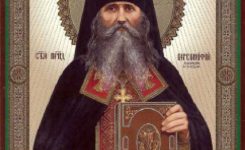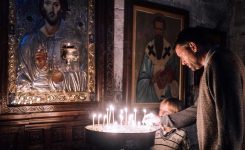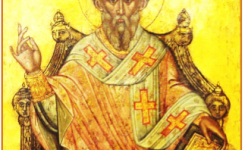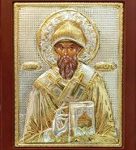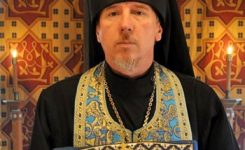monastery musings
The Theotokos: the Border of the Created upon the Uncreated
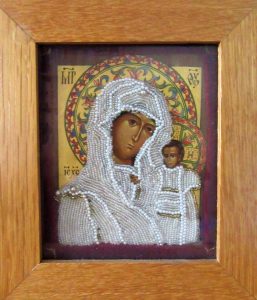
Mother of God Holy Icon with pearls,
Queen of All Skete
The Theotokos: the Border of the Created upon the Uncreated
by
Fr. Constantine Desrosiers
Today I am faced with a truly daunting task. I propose to discuss in an intellectual and scholarly theological manner the All-Holy Theotokos, the Ever-Virgin Mary. Not even the greatest of the ascetics dared to do what I propose and I do ask forgiveness of the Mother of God for my presumption and beg Her to see the innocence of that motivates me.
At the heart of the veneration of the All-Holy Theotokos is the mystery of our salvation, the lynchpin of which is the very incarnation of the divine logos. This must also represent for any objective and candid seeker after Divine Truth the essential characteristic that distinguishes Christianity from all other religions in the world. We are faced today with many religions which fairly claim to be monotheistic, such as Islam and modern Talmudic Judaism whose adherents insist that they are worshipping “the God of Abraham.” They go on to define their “god” as being absolute, transcendent and completely other than men or any created being. In answer, however, to the modern ecumenical claims so often noised about concerning historically significant founders of these monotheistic religions, such as Mohamed, Buddha, and Zoroaster, all of them, to their credit, confess that they are but men and not the transcendent “God” they preach. Like Plato’s great ideas of the true and the good, as well as the Sol Invictus, the Unconquered Sun, of the Neo-Platonists, the “gods” of these historically important prophets”, so called, are beyond them, outside the world, demanding in their absolute self-sufficiency , the submission of man and that he seek them in his life doing “what is good and right.”
On the other side theologically, stand those who indeed claimed to be gods, those gods of mythology, very ancient and not so ancient, such as Zeus and Jupiter, Osiris and Mithras, Vishnu and Krishna, the host of pagan gods celebrated in classical verse by Homer and his epigones, those whom the fourth century (circa 316) Greek philosopher Euhemerus explained were kings and heroes of old, deified by usage and time immemorial, those whom the Prophet-King David in Psalm 95.5 styles as the “god of the heathen (who) are demons.” The point here is that these “gods” are not ontologically transcendent as were the first type, but rather, like the demons they are, quite limited in time, space and power, with more or less distinctive personalities. All of them, as Homer clearly describes them in the Iliad, are big, some ten to twelve feel tall, and immortal. As for the great figures of history who claimed to be gods, from the pharaohs of Egypt to Alexander the Great (356-323 B.C.) to several deified Roman emperors, their cult never outlasted their own power or that of their regime. In modern times it is axiomatic that a divine cult of personality “a la David Koresh or Rabbi Schneerson” is quickly doomed to extinction. In fact, the only such cult of “divine” personality that has amazingly survived over a thousand years is that of Al-Hakim the Mad, the Fatimid ruler of Egypt (996-1021) who destroyed the Constantinian cathedral of the Holy Sepulcher in Jerusalem and precipitated the First Crusade at the end of the eleventh century. He is to this day worshipped as a “god” by the Druses Moslems.
Christ Sinai, 6th c.
In all of this there is one great exception, namely Christianity, whose Divine Founder, Our Lord God and Savior Jesus Christ, because He is transcendent God, easily overcame death and rose from the grave. What is essential for the veracity of Christ’s claim is, as the great Apostle Paul explains, the factual reality of His Resurrection from the tome “trampling down death by death and granting life to those in the graves.” But, on the other hand, this is not what is so ontologically unique, surprisingly and infinitely unique about Christianity, for how could the True and Transcendent God Jesus Christ Yahweh, “He Who Is” by name and definition have remained dead? A storm cloud cannot put out the sun. Rather what makes Christianity unique among all human religions is Christ’s Incarnation, the Mystery of the Great Transcendent God, Yahweh, the Logos, garbing Himself in flesh, as Saint Cyril of Alexandria put it, as in a cloak. The corollary of this Mystery is that the Transcendent God does not stand outside of history and our lives, aloof, urging us to pursue Him by doing good. Rather in His Mystical Love for His creature He runs after us. Saint John the Theologian in First Catholic Epistle (4:10) tell us: “Herein is love, not that we love God, but that He loved us …” As the modern English poet Francis Thompson (1860-1907) styles Him, Christ is the Hound of Heaven Who pursues His
St. Cyril of Alexandria, Cretan icon by Emmanuel Tzanes, 1654
beloved creature, Man, from the sunrise of His Divinity to the sunset of mortality and death. He is like the good and strong sheepdog, with Divine Might and Main pushing man, His lost lamb, from the precipice of sin and snarling down demonic assaults, like those of so many wolves, lions, and jackals.
Saint Paul in his First Epistle to the Corinthians (13:1-8) confesses: “Though I speak with the tongues of men and angels, and have not love, I am become as sounding brass or tinkling cymbal.” Of all the passages of the Pauline Epistles, this is the most famous and the most beloved, especially by Protestants, where the Apostle of the Gentiles catalogues all Christian action even up to martyrdom and all virtues, even faith and almsgiving, showing them to be worthwhile only in so much as they are motivated and carried out with love of Christ. In other words, Christ is Our Divine Lover and we are His beloved. As such we must recognize all men and women as likewise His beloveds, for Whom He shed His Divine Blood. Our calling to respond to His Love must infuse all that we do and even all that we think.
In this, however, we are not without example, for there is One Who perfectly according to human nature and without sin did serve as Her beloved in the most natural and intimate way that any human being can relate to another. This indeed is the tragedy of Protestantism, to know and accept what Saint Paul proclaims to the Corinthians but not to know, not to acknowledge the greatness of the All-Holy Theotokos Who in essence did nothing, initiated nothing, proposed nothing. Rather She merely – it is surely a sin to use such a world – She only responded to the Divine Lover Who became Her Son according to the flesh.
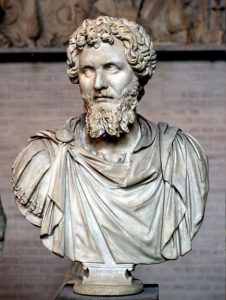
Emperor Septimius Severus bust, Glyptothek Museum, Munich
In this probably lies the reason why the canonical Scriptures of the New Testament are so reserved in speaking of the role and greatness of the Theotokos. It is hard to believe or even imagine this to have been otherwise during the Church’s first three centuries of struggle and persecution, with the recalcitrant Jews ever eager and ready for only a militantly nationalistic Messiah like Simon Bar Kochba (A.D. 132-135), and as the Greek and Roman world went from seeing Christ as nothing but a crucified non-citizen to confusing Him with the pagan gods. Indeed, the early third century Emperor Septimius Severus (A.D. 193-211) did place Our Lord amid the idols of the pantheon. By the mercy of Divine Providence, the world was spared until the late twentieth century the abomination of Christianity sacrilegiously syncretized with goddess-worship. Clearly the struggle for recognition by the
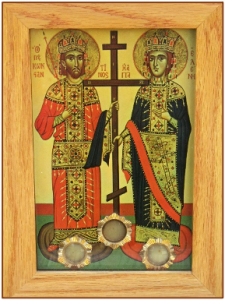
Icon with Relics of St. Constantine, St. Helen & the Holy Cross, Queen of All Skete
Roman Empire and the subsequent submission of the Emperors to Christ had to precede the great Ecumenical Councils, initiated by the Emperor-Saint Constantine and His successors, that defined Christ as True God and True Man. Only in the light of the Christological definitions of the Ecumenical Councils could the role of the Theotokos theologically be clarified and appreciated without blaspheme and idolatry. This came finally with the Third Ecumenical Council of Ephesus in 431.
According to H. Rahner (Zeitschrift fur Katholiche Theologie, 59, 1935, 73-81), the term Theotokos first appears in Christian writing in the third century, in a troparion or hymn and in a text of Saint Hippolytus (222-235), Pope of Rome (cf “Theotokos” by Father Gerhard Podskalsky, S.J., Oxford Dictionary of Byzantium III, 2070). Later the term is used by Saint Athanasius the Great (295-373) in writing Against the Arians. Saint Gregory the Theologian (329-390) (Migne, P.G. 37:177C-180A) writes: “If anyone does not confess that the Virgin Mary is the Theotokos, he is found to be far from God. Whoever maintains that Christ passed through the Virgin as through a channel and was not fashioned in her in a manner at the same time divine and human, in a divine manner because conception occurred without a man, in a human manner because Christ developed in Her according to the principles of nature, whoever maintains this is likewise godless. Whoever maintains that the human being (of Christ) was formed first, an only later did God descend upon Him, is to be condemned.” This is the heresy of adoptionism, championed by the early Gnostic writer Cerinthus (fl. Circa A.D. 100).
But before we go on to the Council of Ephesus in 431, which define the hypostasis of Christ by the application to the Virgin Mary of the title “Theotokos”, we must address the Protestant objection to the celebration of the Theotokos in Her various feasts, the majority of which are not referred to in the canonical books of the New Testament.
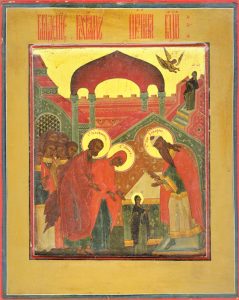
The Entrance of the Theotokos into the Temple, Russian, c. late 19th c.
It is rather in a very small book written in Greek in the middle of the second century that we first find written evidence of the veneration of the Theotokos, more specifically three of Her major feasts: Her Conception from the union of ancestors of God Saints Joachim and Anna, Her Nativity, and Her Entry into the Temple at the age of three. According to the Life composed by the Convent of the Holy Apostles in Colorado (p. VIII), the Protoevangelion dates from the years 130-140, the reigns of the emperors Hadrian and Antoninus Pius. This work is ascribed to the Apostle and First Bishop of Jerusalem, Saint James, the brother of the Lord. The Protoevangelion discusses: 1) the Nativity of the Theotokos, 2) the Entry of the Theotokos into the Temple, 3) the marriage to Joseph, 4) the Annunciation, 5) the journey to Bethlehem, 6) the birth of Christ in the flesh, 7) the visit of the Magi, 8) the slaughter of the babies of Bethlehem by Herod, 9) the flight into Egypt. It testifies to the perpetual virginity of the Theotokos, citing the declaration of the midwives after the Savior’s birth. In treating Joseph, the Protoevangelion describes him as an aged widower with sons from a previous marriage. As I stated, Saint James claims to be its author. In fact, the original title in the Greek manuscripts is the Revelation of James – the Genesis of Mary.
Goodspeed (p. 57) presumes the Protoevangelion to be a Hellenistic Egyptian precisely because it is first cited by the early church writer Origen. Goodspeed calls Origen the greatest scholar and the most prolific Christian writer of the early church period. It is here rather important to dwell a bit on Origen precisely because of the number and scope of his writings which today are divided under the scholarly heading so textual studies, scriptural interpretation, apologetics, and theological treatises. His greatest work was his Hexapla, the setting of six different texts of the Old Testament in six columns to facilitate scholarly study. This work comprised 9000 pages. Epiphanios says he wrote over six thousand works. Saint Jerome asks the question “which of us can read all that he (Origen) wrote?” The significance of this is that, since he was such a strict scholar, his acceptance of the Protoevangelion points to its authentic Orthodox character.
The Protoevangelion was accepted by Clement of Alexandria. Also, there is the question of what came first, the chicken or the egg. We must note that Saint Justin the Philosopher (100-165) writes either earlier or about the same time as the Protoevangelion was written. He does refer to elements of the veneration of the Theotokos such as her perpetual virginity and the miraculous birth of Christ. Thus, we see that elements of the veneration of the Theotokos were already in the tradition of the Church.
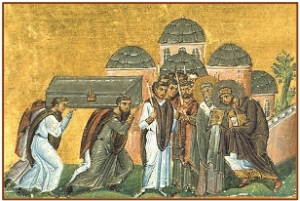
St. Theodosius welcoming the relics of St. John Chrysostom into Constantinople in 438
Let us now return to the Council of Ephesus in 431. The full and most vital question of whether or not the Blessed Virgin Mary can in Orthodox manner be styled the Theotokos was directly addressed at the Third Ecumenical Council held in Ephesus in the year 431 during the reign of the Emperor-Saint Theodosius II (408-450). The controversy was precipitated by the Patriarch of Constantinople Nestorius (428-431) who belonged to the theological school of Antioch which tended to oppose the veneration of the Virgin Mary because of the lack of direct scriptural expression. Nestorius, however, was willing to compromise, accepting the epithets “Christotokos”, the Mother of Christ, and “Theodochos”, meaning “the receptacle or container of God” from the Greek word soch. Opposing the heretical Nestorian position stood the great patriarch of Alexandria, Saint Cyril (412-444) who strove to preserve the Orthodox understanding of the unity of the God-Man as necessary to procure human salvation. Saint Cyril defined Christ as one person or hypostasis. This Cyrillic
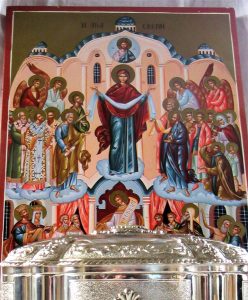
Protection of the Mother of God (Pokrov) icon with a reliquary containing a piece of the Holy Belt of the Theotokos,
Queen of All Skete
understanding of Our Lord’s Hypostatic Union with man was accepted first by Pope Celestine I (422-432) at the Synod of Rome and then by the Council of Ephesus (431). The result was the infallible proclamation by the Council of what already had been believed, that the Virgin Mary was indeed the Theotokos, the Mother of God in the sense of His birthgiver.
Less than two centuries later, the Theotokos had already come to be regarded as both the Patroness and Protectress of Constantinople. By the fifth century, the Zwnή or Cingulum, the Holy Belt of the Mother of God had been formally translated to the New Roman Capital, to be enshrined first in the church of Chalkoprateia and later in the Cathedral at Blachernai. This marvelous relic soon became, as it were, the equivalent to the ancient Palladium of Troy, the spiritual guarantee of the City’s safety. Several feasts celebrate the placing of this Cincture of the All-Holy Theotokos, most notably on the last day of the Church year, August 31/September 13.
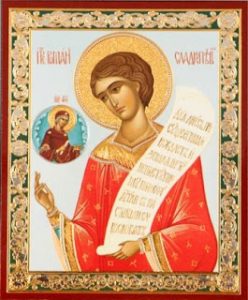
St. Romanos the Melodist being enlightened by the Theotokos, Russian icon
During the reign of the great Emperor-Saint Justinian (527-565), the Roman Lawgiver, the Restorer of the Western Empire and the Builder of the Imperial Cathedral of Hagia Sophia, the Holy Archdeacon Romanos the Melode (died 555) claimed that he had written a thousand hymns under the inspiration of the All-Holy Theotokos. Of these only 85 survive. What is particularly noteworthy is the fact that the liturgical order of hymns which Saint Romanos developed, namely a succession of Kontakia and Oikoi, was eventually supplanted during the eighth century by the order of canons which even to our day comprise the second half of Matins in the All-Night Vigil. There is however, one noteworthy exception for as you all know, the great Akathist Hymn is still celebrated following the liturgical order of Saint Romanos the Melode.
While pious tradition attributes the authorship of the Akathist Hymn to Saint Romanos, scholarly opinion tends to claim Patriarch Sergius (610-638). This was a time of great crisis in the seventh century when it was in doubt whether the Roman Empire would survive, first the Persian threat of the Sassanids and then the veritable onslaught of the Moslems. The Persians in 614 captured Jerusalem and in the Iranian fashion carried off as hostage the True Cross of Christ to Ctesiphon. The Emperor Heraclius (610-641), confronted by the Sassanid army at Chalcedon, right in front of Constantinople in 615, even contemplated moving the Roman capital to Carthage in North Africa. Patriarch Sergius, to the eternal gratitude of Latin teachers of Virgil’s Aeneid, opposed this move. The Patriarch became regent of the City of Constantinople in 622, as the Emperor Heraclius and his army marched north through the Transcaucasus to attack the rear of the Persian Empire. By 626 the horde of Turko-Mongolian Avars were laying siege to Constantinople but the city led by the Patriarch trusted their safety and salvation to their heavenly Protectress, the All-Holy Theotokos, chanting to Her The Akathist without ceasing during the siege. The campaign ended in triumph in 626 with the Avars driven back and the True Cross was recovered. The Emperor Heraclius, having destroyed the
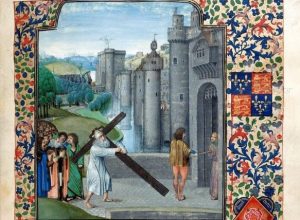
Heraclius carrying the True Cross – British Library MS Royal 15 E. i, fol. 16
Sassanid Persian Empire, personally clad only in a simple white tunic, carried the True Cross of Our Lord back to Jerusalem. Alas, the glow of this victory was short lived, for soon the Moslems burse out of Arabia to capture Jerusalem in 637 and Alexandria in 643. In 673 they came to threaten Constantinople. Even worse, Patriarch Sergius who had been such a hero, both politically and religiously, fell later into the heresy of Monotheletism in 638 with the publication of the Ecthesis. His ally in this notably was Pope Honorius I (625-638), while the defender of Orthodoxy in this last Christological crisis was Saint Sophronius, Patriarch of Jerusalem (634-638), who surrendered the Holy City to the Moslems.
The full theology of the All-Holy Theotokos was probably most fully and clearly
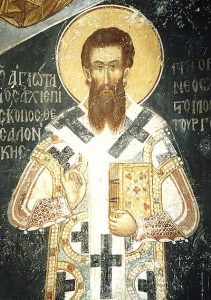
St. Gregory Palamas, Monastery of Vatopaidi, Mount Athos, Greece
propounded by Saint Gregory Palamas (1296-1359), Archbishop of Thessalonica. In his fifth Homily (Migne, P.G. 111.64B-D) he describes the ancestral condemnation of man, from which all personal sins flow. Christ stands as the liberator of human nature who “transforms the common curse into a common blessing.” In this way, as it were, predestinating man for heavenly bliss: “having taken on our guilty nature from an undefiled Virgin, He made it guiltless and justified, so that those born of Him (by Holy Baptism) are thereafter in spirit set apart from the ancestral curse and condemnation.”
In [Mignes] hom. 16 (192C) there is the following: “The rising up of the flesh is against the will (άkoύsioV) and patently strives against the law of the mind; even though by chaste men it is forced into subjection and employed only for procreation, still it brings with it the initial curse, as it is and is named corruption, and properly generates to corruption and, for the man who is ignorant of the honor which our nature has obtained from God, it is a movement of passion likening him to beasts.”
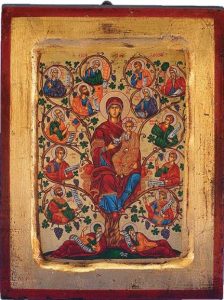
The Virgin Mary “Tree of Life”
The result of this is that the pleroma (plήrwma) Or fullness of the Divine Godhead would not be able to be born from a conception of corrupt human seed. At the same time the Blessed Virgin Mother must remain truly human in her nature, for although no one save Adam had sinned in the Original Sin, yet all of his descendants suffered the results of his separation from God, due to the strange new weakness and disorder in their nature. Although God rejoices in the good acts and good will of post-Adamic man his nature is ever prone to fall into sin subject thus to death and cut off from abiding Salvation with His Creator. In this way, God sees fit to require the free choice of the All-Holy Virgin born of saintly parents and a barren woman in order to consummate, as it were, His union efficaciously with the nature of man.
The Roman Catholic dogma of the Immaculate Conception cuts roughly through the subtle theology of Saint Gregory. In a way it assumes almost a semi-Monophysite position, by somewhat diluting the human nature of the All-Holy virgin with a super-human Divine quality. If I may use a few similes from the natural world: It is as if a chemist were to attempt to super purify water by altering its chemical nature of H2O, adding as it were more oxygen or more hydrogen. By contrast, the Orthodox understanding is more like what happens in nature when there is a full moon. Julius Caesar speaks often of the great high tides off the French and British coasts in September. As the moon draws naturally upon the sea, great waves are created and as they break, at their very apex, the water is no longer dark and blue, but rather all white and foamy, fully aerated and full of light. In a way analogous, Our Divine Savior by His grace drew up, as it were, a great wave of royal Davidic ancestors of Himself, so that in the fullness of time, at the apex of the wave stood the All-Holy Virgin, clearly unique among humankind for the surpassing degree of divine possession of her being but not different in nature from the rest of mankind (Nicholas Cabasilas says at much in his work, entitled The Divine Liturgy).
Alas, at this point, the analogy breaks down, for the moon never then follows its beams to plunge into the waves. I quote the following from Vladimir Lossky, The Mystical Theology of the Eastern Church, London, 1957, original French edition Paris, 1944, pp. 30, 31: “In the Irmos of the Fourth Canticle of the Canon of the Holy Annunciation, March 25/April 7, which so often is repeated Saturday after Saturday as a Katavasia, the All-Holy Ever-Virgin Theotokos is called the ‘Light Cloud’ in which Christ comes, the Sun of the Superessential Universe.” Indeed, as we chant the hymn of Saint Sophronius of Jerusalem, O Gladsome (Joyous) Light, at Vespers, the understanding is precisely that Christ, the Pre-eternal God, like the setting sun, sinks into the cloud of the All-Holy Virgin’s humanity, becoming thereby soft for our weak eyes to behold in the flesh.
Before leaving, however, the issue of the Immaculate Conception, let me urge, in spite of this error, that we not disdain too much the traditional devotion to the Blessed Virgin Mary in Roman Catholic tradition. If we scan the full range of Christian history, we see the All-Holy Theotokos, or rather, the faithful devotion to Her as a great border of piety. Those heretics from Nestorius in the modern Protestants stand on one side refusing to honor the All-Holy Theotokos, while the traditional Roman Catholics, as well as the Monophysites, especially the Copts of Egypt, stand with the Orthodox, in recognizing Her Supreme importance for our salvation. The British Catholic author, Gilbert Keeth Chesterton is not wrong when he states that those who refuse to venerate the All-Holy Theotokos, will soon cease from worshipping Her Divine Son. I do believe that it was precisely the abiding veneration of the All-Holy Mother of God that preserved so much of Orthodox tradition among Roman Catholics, for as we ourselves have seen with our own eyes, when the Second Vatican Council turned away from the Blessed Virgin, their gates failed and the flood of modernism carried almost all before it.
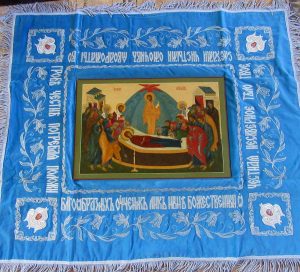
Epitaphios/Plaschinitza of the Theotokos, Queen of All Skete
By contrast, however, the place occupied by the All-Holy Theotokos in Orthodoxy is much higher and more august than among any other Christians. No liturgical service exists without prayers to Her. She is called upon in every Ektenia and every Friday is devoted to Her veneration. An entire Lent, stricter than any save the Great Lent, precedes Her great final Feast of the Dormition. Far more numerous are Her feasts among the Orthodox than among Russian Catholics, who did however, reserve for her in private devotion, the months of May and October, the month of the Rosary. The most popular miraculous icons venerated by Catholics today were in their origin Orthodox, to wit: Our Lady of Perpetual
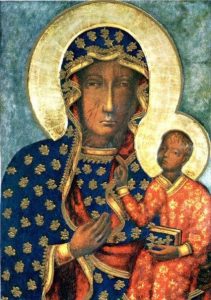
Our Lady of Częstochowa
Help which originated in Crete and Our Lady of Częstochowa in Poland. But then there is Our Lady of Guadalupe, which seems to be a truly miraculous intervention of the Mother of God to protect the newly Christianized Indians of Mexico. Yet how little is this in comparison to the 200 wonderworking icons venerated alone in the Russian Church, not to mention the 300 additional icons of the All-Holy Theotokos which are greatly venerated in the Russian Church.
Saint John of Kronstadt writes: “Her numerous holy icons are as different reflections of one and the same face. You may sometimes have seen how the human face is reflected in a broken mirror in a multitude of separate images, according to the number of pieces in which the mirror was broken, or in every bubble of water, or in every drop of dew, and in the pupil of the human eye. If this is possible and is a common phenomenon in nature, then why should not we Orthodox Christians allow numerous representations of one and the same face – of the Lord, or of His Most Pure Mother, or of a Saint, and see in each image the Lord Himself, or His Most Pure Mother as we see in a mirror or in pictures numerous of one and the same face.”
One can say that the very history of Russian Orthodoxy begins with a miracle of the Mother of God. During the reign of the Emperor Leo VI the Wise (870-912), in the year 907 Prince Oleg the Varangian led the still pagan Rus to attack Constantinople. Again, as in the time of the Avars three centuries earlier, the Christian Roman Byzantines cried out to their All-Powerful Patroness Who saved them from the Russian. The Feast of the Protection or Pokrov celebrated on October 1/14 recalls this miracle, making the Russians themselves quite unique among the nations of the world. Who else annually celebrates the defeat of their own ancestors?
Actually the pagan Russians several times with their fleet laid siege to Constantinople. Rurik in 860 appeared before the new Roman Capital. Later in 941 Prince Igor whose wife was Saint Olga Equal to the Apostles also made his assault in 941, as did their son Sviatoslav in 972, only 16 years before the conversion of Kievan Rus in 988 for Saint Vladimir Equal to the Apostles was his son.
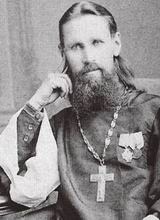
St. John of Kronstadt
Let me end my talk with the inspiring words of Saint John of Kronstadt: “She is one flesh and one spirit with the Saviour. The Mother of God is one flesh and blood, and one spirit with the Saviour as His Mother. So infinitely great was Her worthiness by the grace of God that She become the Mother of God Himself, giving Him most pure and sacred flesh, nourishing Him with Her milk, Carrying Him in Her arms, clothing Him, caring in every way for Him in His Infancy, kissing Him and caressing Him. O Lord, who can describe the greatness of the God-bearing Virgin? ‘Every tongue is in doubt as how worthily to praise Thee, and even the angels wonder how to hymn Thee, O Mother of God’.”

